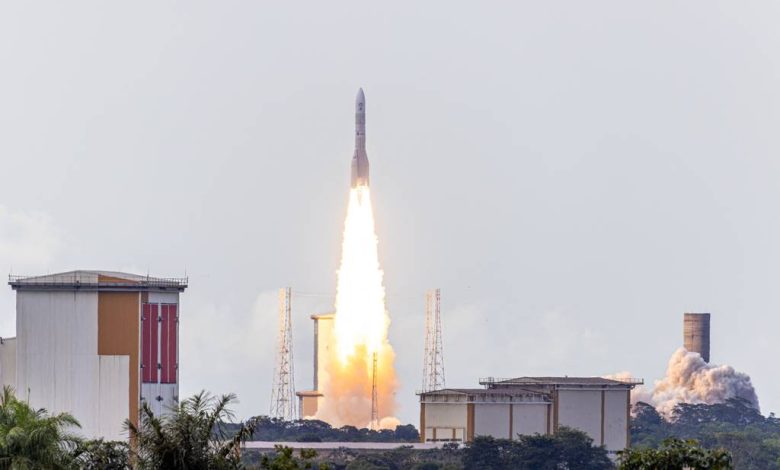Ariane 6 launch returns in-house space access to Europe’s armed forces

PARIS — Europe restored sovereign access to space with the first launch of the Ariane 6 heavy-lift rocket on Tuesday, after years of delays and retirement of the previous launcher had left the continent without guaranteed access to orbit, and kept a French spy satellite grounded.
The all-new Ariane 6 blasted off from French Guiana for a validation flight loaded with scientific experiments and testing equipment. The next flight planned for December will carry CSO-3, a French military-surveillance satellite that had originally been scheduled for launch in 2021.
“This first successful launch of Ariane 6 finally gives Europe back its capacity to access space,” Philippe Baptiste, the head of French space agency CNES, said in a statement.
The first launch of Ariane 6, originally planned for 2020, had been pushed back by technical issues as well as the Covid-19 pandemic. Russia broke off space cooperation in 2022 after its invasion of Ukraine, meaning Europe could no longer use the Soyuz launchers as a stop-gap measure, and leaving the continent reliant on commercial providers including SpaceX for heavy space lift.
The most urgent upcoming military missions for Ariane 6 are observation satellites including CSO-3, according to Paul Wohrer, a research fellow specialized in space issues at the French Institute of International Relations, or IFRI. France also still has to launch the Yoda agile satellite demonstrator, after the small patroller satellite was held up by a lack of launch slots.
The lack of autonomous access to space was “becoming dangerous,” leaving Europe unable to launch satellites that are “extremely sensitive and extremely useful for our armed forces,” according to Wohrer, and pushing back future programs such as the French IRIS military-observation satellites.
European armies “need this type of space capability, particularly at a time when war is on Europe’s doorstep,” Wohrer said. “The war in Ukraine clearly demonstrated the importance of space. We seem to be entering a period in which the ability to access space will become increasingly strategic.”
While military satellites made up a limited share of Ariane 5 launches, the retired rocket’s final mission in July 2023 lifted the French Syracuse 4B military communications satellite into orbit, as well as Germany’s Heinrich-Hertz-Satellit with a dual civilian-military communications payload.
Over a 27-year career, Ariane 5 placed the military communications systems for the major western European states in orbit: Skynet 5 for the U.K., Syracuse 3 and 4 for France, Sicral-2 for Italy, Secomsat and SpainSat for Spain and Satcom BW for Germany’s Bundeswehr.
The new rocket has an order book for 30 launches, Caroline Arnoux, head of the Ariane 6 program at Arianespace, said in a press briefing on June 25. After two launches planned for this year, the pace will increase to six in 2025, eight the following year and ten in 2027. About a third of the missions are for government customers, including the military.
The primary goal of Ariane 6 is to serve European institutional missions and ensure they can reach space, which is the core reason for public funding of the launcher, according to Lucia Linares, head of space transportation strategy and institutional launches at the European Space Agency. The new rocket will the “Europe’s workhorse for guaranteed access to space,” Linares said at the June 25 briefing.
An Ariane 6 launch may initially be in the order of tens of millions of dollars more expensive than a launch by SpaceX of the reusable Falcon 9, according to Wohrer. That probably won’t hold back European armed forces from favoring the domestically-produced rocket, he said.
“It’s unlikely that the difference in costs will be enough for the military not to buy European launchers,” Wohrer said. “At what point does it become an unbearable factor? It’s a bit like the cost of security, the cost of ensuring strategic autonomy in terms of access to space.”
ESA is working on a reusable rocket engine called Prometheus, with ArianeGroup the lead contractor, with the goal of making a “very low-cost” engine that can be built at one-tenth of the cost of the Vulcain 2 that powered the Ariane 5.
Launching military or dual-use satellites on a foreign rocket risks revealing secrets, and it puts Europe at the mercy of foreign competitors’ prices, as was the case with the EU paying SpaceX a premium for security measures around the launch of Galileo navigation satellites, according to Wohrer. The lack of autonomous launch capacity “is something quite dangerous, quite risky,” he said.
European countries will have to think about bolstering their capabilities to gather intelligence from space if they want to be less reliant on the United States, according to Wohrer. The European parliament has raised concerns about depending on the U.S. in terms of space security, saying this could contradict the EU’s desire to achieve strategic autonomy.
“If this is the kind of development we’re heading for, access to space will be absolutely essential,” Wohrer said. “I don’t think you can be a major military power today without access to space. Frankly, space has become extremely useful for waging war and conducting operations.”
Rudy Ruitenberg is a Europe correspondent for Defense News. He started his career at Bloomberg News and has experience reporting on technology, commodity markets and politics.







